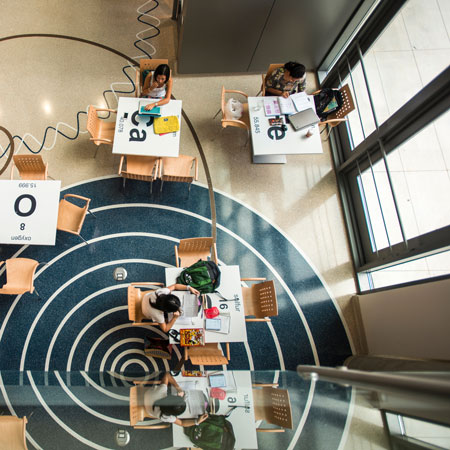Calendar
To submit your event to the College of Science events calendar, use the “post your event” button. Student groups, other Mason units, and external groups with activities related to the College of Science are welcome to submit events for the calendar. If you have any questions or need to edit or delete your event, please email the COS webmaster at cosweb@gmu.edu.
Did you know that you can subscribe to this calendar? If you’d like to be notified of new events and even have them added to your own Outlook or Google calendar automatically, use the “Subscribe” button below the calendar.

Dissertation Defense
Candidate: Muhammad N. Baqui
Title: Automated Monitoring of High Density Crowd Events
Abstract:
Pedestrian traffic is an important subject of surveillance to ensure public safety and traffic management, which may benefit from intelligent and continuous analysis of Pedestrian traffic videos. State-of- the-art methods for intelligent pedestrian traffic surveillance have a number of limitations in automating and computing useful pedestrian traffic information from closed circuit television (CCTV) images. This work aims to automate and augment the traditional pedestrian traffic surveillance system by introducing four components in a novel integrated framework. A fast and efficient particle image velocimetry (PIV) technique is proposed to yield pedestrian velocities for timely management of pedestrian traffic. A machine learning-based regression model, boosted Ferns, is used to improve pedestrian count estimation: an essential metric for high-density pedestrian traffic analysis. A camera perspective model is proposed to improve the speed and position estimate of pedestrian traffic incorporating camera’s intrinsic and extrinsic parameters. All these functional improvements are integrated in a seamless framework to predict future pedestrian traffic distribution, which is a crucial piece of information for pedestrian traffic management. The proposed framework is computationally efficient, suitable for multiple camera feeds with high-density pedestrian traffic videos, and capable of rapidly analyzing and predicting flows of thousands of pedestrians. The proposed framework is one of the first steps towards fully integrated CCTV-based automated pedestrian traffic management system.
Director or Committee Chair:
Rainald Löhner
Committee:
Juan Cebral, Chi Yang, Jan Allbeck
Notes: A copy of Muhammad’s dissertation is available for examination from Karen Underwood, Department of Computational and Data Sciences, 373 Research Hall. The dissertation is available to read only within the Department and cannot be taken out of the Department or copied.
The thesis is on reserve in the Johnson Center Library, Fairfax Campus. All members of the George Mason University community are invited to attend.

Dissertation Defense
Candidate: Brian Corgiat
Title: Molecular mechanisms underlying visual recognition memory in rhesus monkey
Abstract:
Visual recognition memory is the ability to identify previously encountered objects as familiar and enables us to recognize our family and friends and to navigate from one place to another. Visual recognition memory is critically dependent upon the perirhinal cortex (PRh). More specifically, visual memory formation requires cholinergic activation of the m1 muscarinic acetylcholine receptor (m1AChR) in PRh and is also characterized by enhanced multiunit activity in the upper middle and deep PRh layers. However, the M1 muscarinic-dependent intracellular signaling pathways underlying the critical synaptic changes induced during visual memory formation remain unknown.
The first research aim of this dissertation is to develop a proteomic approach to study the intracellular signaling pathways that underlie visual recognition memory in a cortical layer- and subregion- specific manner in nonhuman primate (NHP). Protein phosphorylation is highly dynamic, and phosphoproteins must be stabilized quickly to preserve their in vivo phosphorylation state. Common fixation techniques, such as transcardial perfusion with formalin/paraformaldehyde, are inadequate at preserving in vivo phosphoprotein levels. Additionally, many standard phosphoprotein quantification methods suffer from limited sensitivity (e.g., immunohistochemistry) or require substantial amounts of tissue per assay (e.g., Western blot), rendering them incompatible for studying subregion- and layer-specific signaling in NHP brain regions. A workflow was established able to measure cortical layer-specific phosphoprotein signaling pathways in NHP using laser-capture microdissection and reverse phase protein microarrays. Using this workflow, the impact of two parameters likely to be encountered in future behavioral experiments were assessed: the cold ischemia time post euthanasia and the choice of anesthetic. Further, baseline phosphoprotein signaling in critical brain regions were measured. Ultimately, this first aim established a technical framework for studies of protein signaling networks that underlie cognitive processes in nonhuman primates.
The second research aim was to assess protein signaling activation after visual memory formation in PRh. Monkeys were trained on a delayed nonmatching-to-sample (DNMS) task, a test of recognition memory, to drive cholinergic activation of the m1AChR and activation of m1AChR-depedent protein pathways in PRh. After extensive training on the DNMS task, monkeys were euthanized, and the tissue collected and processed for a cortical layer-specific analysis of m1AChR-dependent protein pathway activation. Initial clustering analyses revealed no dramatic change in m1AChR-dependent pathway activation after memory training, thus a multi-level model will be developed to parse apart m1AChR-dependent protein pathway activation after recognition memory training.
The third and final aim of this dissertation was to assess the impact of an m1AChR-related potassium channel, the Kv7 KCNQ channel, and an m1AChR-dependent signaling pathway, the mechanistic target of rapamycin (mTOR) pathway, using a standard pharmacological approach. KCNQ channel openers and closers and an mTOR pathway inhibitor were directly microinfused into PRh in monkeys performing one-trial visual recognition. Neither the KCNQ channel manipulations nor the mTOR inhibition impaired monkeys performance on one-trial visual recognition.
In summary, the work in this dissertation developed a new approach to study cortical layer-specific protein pathway activation in monkey and this approach was used to assess m1AChR-depedent signaling after visual memory formation. Additionally, other m1AChR-related mechanisms, such as modulation of KCNQ channels, were found to have limited impact on visual recognition.
Director or Committee Chair:
Dr. Lance Liotta
Committee:
Dr. Claudius Mueller
Dr. James L. Olds
Dr. Kim Blackwell
Dr. Janita Turchi
Notes: The thesis is on reserve in the Johnson Center Library, Fairfax Campus. All members of the George Mason University community are invited to attend.


